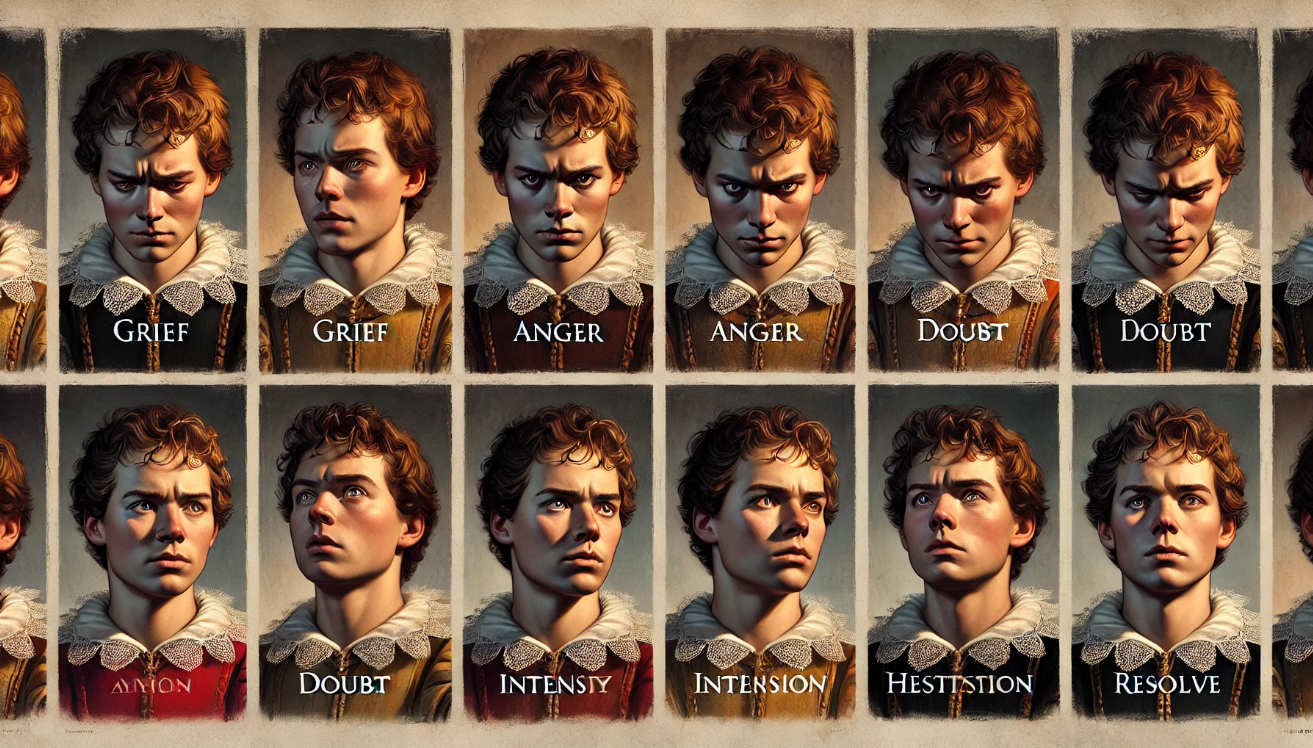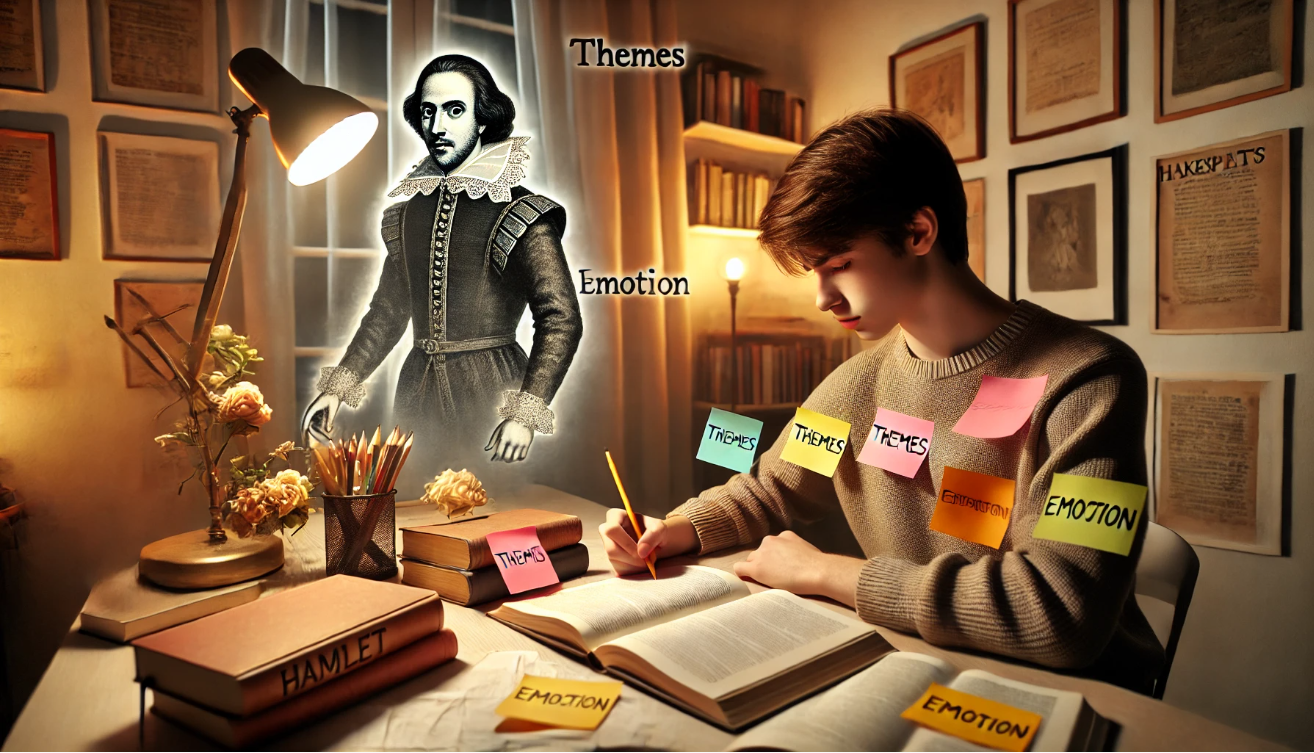
Deep Analysis of Hamlet’s Soliloquies: Unraveling Themes, Emotions, and Shakespeare’s Genius
What makes Hamlet’s soliloquies so captivating, even centuries later? These introspective speeches reveal the tormented mind of Shakespeare’s iconic prince, grappling with life, death, and revenge. Whether you’re a student struggling to decode their meaning or a literature lover seeking deeper insight, understanding Hamlet’s soliloquies unlocks a timeless exploration of human emotions. This article offers a clear, engaging analysis of these profound monologues, breaking down their themes and significance with beginner-friendly clarity. Get ready to discover why Hamlet’s words still resonate and how they can inspire your own reflections on life’s big questions!
Table of Contents
Toggle1: What Are Soliloquies and Why Do They Matter in Hamlet?

Understanding Soliloquies in Shakespeare’s Work
A soliloquy is a dramatic device where a character speaks their thoughts aloud, alone on stage, revealing their innermost feelings to the audience. In Hamlet, Shakespeare uses soliloquies to dive deep into the mind of the troubled Prince of Denmark. These speeches aren’t just poetic rants—they’re windows into Hamlet’s struggles with grief, morality, and revenge. 😊
Why do they matter? Soliloquies let us hear Hamlet’s unfiltered emotions, like his famous “To be, or not to be” speech, which wrestles with life and death. They make the play relatable, showing universal human conflicts. For students or readers, understanding soliloquies unlocks Shakespeare’s genius, making complex themes like existentialism and betrayal accessible. By analyzing them, you’ll see how Hamlet’s inner turmoil drives the story, offering insights you can apply to literature studies or even personal reflection.
2: Overview of Hamlet’s Major Soliloquies

A Guide to Hamlet’s Seven Soliloquies
Hamlet’s seven soliloquies in Shakespeare’s Hamlet reveal the prince’s inner world, from rage to despair. This guide summarizes each one, making them easy to understand for beginners while highlighting their emotional depth. Let’s explore these iconic speeches! 😊
Soliloquy 1 (Act 1, Scene 2: “O, that this too too solid flesh would melt”)
Hamlet grieves his father’s death and his mother’s quick remarriage. He feels trapped, wishing to escape his “solid flesh.” This sets up his emotional turmoil and disgust with the world.
Soliloquy 2 (Act 1, Scene 5: “O all you host of heaven!”)
After meeting his father’s ghost, Hamlet vows revenge against Claudius. His shock and anger drive the play’s central conflict, showing his determination but also his fear.
Soliloquy 3 (Act 2, Scene 2: “O, what a rogue and peasant slave am I!”)
Hamlet berates himself for hesitating to act. Comparing himself to an actor’s passion, he plans to test Claudius’s guilt with a play, revealing his self-doubt and cunning.
Soliloquy 4 (Act 3, Scene 1: “To be, or not to be”)
The most famous soliloquy! Hamlet ponders life, death, and suicide, weighing the fear of the unknown against his suffering. It’s a universal reflection on existence. 🌟
Soliloquy 5 (Act 3, Scene 2: “’Tis now the very witching time of night”)
Energized by the play’s success in proving Claudius’s guilt, Hamlet feels ready for revenge. His dark, intense tone shows a shift toward action.
Soliloquy 6 (Act 3, Scene 3: “Now might I do it pat”)
Hamlet finds Claudius praying but hesitates to kill him, fearing his soul would go to heaven. This shows his moral struggle and overthinking nature.
Soliloquy 7 (Act 4, Scene 4: “How all occasions do inform against me”)
 Inspired by an army’s resolve, Hamlet questions his own inaction. This final soliloquy pushes him toward decisive action, setting the stage for the tragedy’s climax.
Inspired by an army’s resolve, Hamlet questions his own inaction. This final soliloquy pushes him toward decisive action, setting the stage for the tragedy’s climax.
These summaries give you a clear starting point to dive into Hamlet’s mind. Each soliloquy builds on the last, making them key to understanding the play’s themes and Hamlet’s journey.
Unraveling the Core Themes
Hamlet’s soliloquies are more than poetic speeches—they’re a window into universal human experiences. By exploring their major themes, we can connect Hamlet’s struggles to our own lives. This section breaks down the core themes in a clear, beginner-friendly way, helping you grasp Shakespeare’s genius and apply these insights to your studies or personal reflection. Let’s dive in! 😊
Mortality and the Meaning of Life
In the famous “To be, or not to be” soliloquy (Act 3, Scene 1), Hamlet wrestles with life’s purpose and the fear of death. He questions whether enduring pain is better than facing the unknown of death, a dilemma anyone facing tough choices can relate to. This theme invites readers to reflect on their own views about existence.
Revenge and Justice
Hamlet’s vow to avenge his father’s murder (Act 1, Scene 5) drives the play. His soliloquies reveal his inner conflict about taking justice into his own hands, especially in Act 3, Scene 3, when he hesitates to kill Claudius. This theme resonates with anyone grappling with moral decisions or seeking fairness.
Self-Doubt and Inaction
Hamlet’s self-criticism in “O, what a rogue and peasant slave am I!” (Act 2, Scene 2) highlights his struggle with indecision. His overthinking delays action, a feeling familiar to those who’ve ever felt paralyzed by doubt. Recognizing this can help readers understand procrastination in their own lives.
Betrayal and Trust
In Act 1, Scene 2, Hamlet’s pain over his mother’s quick remarriage reveals his sense of betrayal. This theme of broken trust runs through his soliloquies, mirroring real-world experiences of navigating relationships and loyalty. It’s a reminder to value trust in our connections.
These themes make Hamlet’s soliloquies timeless, offering insights into human emotions. By understanding them, you can better analyze the play or reflect on your own challenges, making Shakespeare’s work feel relevant and approachable. 🌟
4: Emotional Depth and Psychological Insights

Hamlet’s Emotions Laid Bare
Hamlet’s soliloquies pull back the curtain on his raw emotions, making him one of literature’s most relatable characters. By diving into his psychological complexity, readers can empathize with his struggles and connect them to their own lives. This section explores the emotions driving Hamlet’s words, offering insights that make Shakespeare’s work feel alive and relevant. Let’s uncover his inner world! 😊
Grief and Despair
In “O, that this too too solid flesh would melt” (Act 1, Scene 2), Hamlet’s grief over his father’s death and his mother’s remarriage is palpable. His wish to “melt” reflects deep despair, a feeling anyone who’s lost a loved one can understand. This soliloquy shows how grief can shape our worldview.
Anger and Betrayal
Hamlet’s rage erupts in “O all you host of heaven!” (Act 1, Scene 5) after learning of his father’s murder. His sense of betrayal by his mother and uncle fuels his resolve for revenge. This intense emotion resonates with anyone who’s felt let down by those they trusted.
Self-Doubt and Inner Conflict
In “O, what a rogue and peasant slave am I!” (Act 2, Scene 2), Hamlet’s frustration with his own inaction reveals a mind at war with itself. His self-doubt mirrors moments when we question our courage or decisions, making his struggle deeply human.
Existential Angst
The “To be, or not to be” soliloquy (Act 3, Scene 1) captures Hamlet’s fear of the unknown and his existential dread. His thoughts on life, death, and the afterlife echo universal questions about purpose, inviting readers to reflect on their own uncertainties. 🌟
By exploring these emotions, you can connect with Hamlet’s journey on a personal level. Whether you’re studying the play or seeking to understand complex feelings, these soliloquies offer a roadmap to navigate your own emotional depth with clarity and confidence.
5: Shakespeare’s Genius in Crafting Soliloquies

The Artistry Behind the Words
Shakespeare’s soliloquies in Hamlet are masterpieces of language and emotion, showcasing his unparalleled skill as a playwright. By examining his literary techniques, readers can appreciate how he brings Hamlet’s inner world to life. This section breaks down the artistry behind these speeches in a beginner-friendly way, helping you see why Shakespeare’s work endures. Let’s explore his genius! 😊
Vivid Imagery
Shakespeare uses rich images, like Hamlet’s wish for his “too too solid flesh” to “melt” (Act 1, Scene 2), to paint vivid pictures of despair. This makes complex emotions feel real and relatable, drawing readers into Hamlet’s mind.
Rhythmic Language
The iambic pentameter in soliloquies, such as “To be, or not to be” (Act 3, Scene 1), creates a natural, heartbeat-like rhythm. This musical quality makes the words memorable and emotionally powerful, even for first-time readers.
Rhetorical Questions
Hamlet’s soliloquies, like “What a rogue and peasant slave am I!” (Act 2, Scene 2), are filled with questions that mirror his inner turmoil. These engage readers, prompting them to ponder life’s big questions alongside Hamlet.
Emotional Shifts
Shakespeare masterfully shifts tones within soliloquies, as in Act 3, Scene 3, where Hamlet moves from resolve to hesitation. This dynamic flow reflects real human emotions, making the speeches feel authentic and universally relatable. 🌟
By understanding these techniques, you can appreciate Shakespeare’s craft and apply this insight to analyze other literature or even improve your own writing. His soliloquies turn complex ideas into accessible, emotional experiences that resonate across centuries.
6: Practical Tips for Analyzing Soliloquies

How to Analyze Hamlet’s Soliloquies Like a Pro
Analyzing Hamlet’s soliloquies can feel daunting, but with the right approach, anyone can uncover their depth and meaning. These practical, beginner-friendly tips will help you break down Shakespeare’s words with confidence, whether for school, personal study, or pure enjoyment. Let’s make analyzing soliloquies fun and easy! 😊
- Read Aloud
Speak the soliloquy out loud to feel its rhythm and emotion. For example, try “To be, or not to be” (Act 3, Scene 1). Hearing the words helps you catch Shakespeare’s tone and makes the text less intimidating. - Identify the Context
Ask: What’s happening in the play when Hamlet speaks? In Act 1, Scene 2, he’s grieving his father’s death. Knowing the context helps you understand why he feels a certain way, making the soliloquy’s emotions clearer. - Spot Key Themes
Look for recurring ideas like death, revenge, or doubt. In “O, what a rogue and peasant slave am I!” (Act 2, Scene 2), Hamlet’s self-doubt stands out. Jotting down themes helps connect the soliloquy to the play’s bigger picture. - Focus on Language
Notice vivid words or phrases, like “slings and arrows” in Act 3, Scene 1. These images reveal Hamlet’s feelings. Highlighting them makes it easier to see Shakespeare’s artistry and emotional depth. - Ask What It Reveals About Hamlet
Each soliloquy shows a side of Hamlet’s personality. In Act 4, Scene 4, his resolve grows stronger. Consider how his thoughts evolve to track his psychological journey. - Connect to Your Life
Relate Hamlet’s struggles to your own experiences. His hesitation in Act 3, Scene 3 might remind you of a tough decision. This makes the soliloquies feel relevant and engaging. 🌟

Use these tips to analyze any soliloquy with ease. They’ll help you uncover meaning, ace your assignments, or simply enjoy Shakespeare’s genius in a new way!
Hamlet’s soliloquies are timeless windows into the human soul, blending raw emotion, profound themes, and Shakespeare’s brilliant artistry. From grappling with life’s meaning to wrestling with doubt and revenge, these speeches make Hamlet’s struggles feel universal and relatable. By exploring their themes, emotions, and techniques, you’ve gained tools to analyze literature with confidence and connect Shakespeare’s words to your own life. Whether you’re a student, a literature enthusiast, or just curious, these soliloquies offer endless insights. Keep exploring, and let Hamlet’s voice inspire your own reflections! 😊
Frequently Asked Questions (FAQs)
1. What is a soliloquy in Hamlet?
A soliloquy is when a character, like Hamlet, speaks their thoughts aloud alone on stage. In Hamlet, these speeches reveal his inner emotions and struggles. They help the audience understand his complex feelings about life, death, and revenge.
2. Why are Hamlet’s soliloquies important?
Hamlet’s soliloquies show his deepest thoughts, driving the play’s themes like mortality and betrayal. They make his character relatable and reveal Shakespeare’s skill in exploring human emotions. Understanding them helps readers connect with the story and its universal ideas.
3. How many soliloquies does Hamlet have?
Hamlet has seven soliloquies in the play. Each one, like “To be, or not to be,” highlights a different stage of his emotional and psychological journey. They range from grief and anger to self-doubt and resolve.
4. What is the main theme of “To be, or not to be”?
This famous soliloquy (Act 3, Scene 1) explores life, death, and the fear of the unknown. Hamlet questions whether enduring suffering is better than facing death’s uncertainty. It’s a universal reflection on existence that resonates with many readers.
5. How can I analyze Hamlet’s soliloquies for school?
Read the soliloquy aloud, note its context in the play, and identify key themes like revenge or doubt. Look for vivid imagery and rhetorical questions to understand Hamlet’s emotions. Connect the speech to your own experiences for deeper insight.
6. What emotions does Hamlet express in his soliloquies?
Hamlet shows grief, anger, self-doubt, and existential fear in his soliloquies. For example, he’s despairing in Act 1, Scene 2, and conflicted about revenge in Act 3, Scene 3. These emotions make him a complex, relatable character.
7. How does Shakespeare use language in Hamlet’s soliloquies?
Shakespeare uses vivid imagery, rhythmic iambic pentameter, and rhetorical questions to bring Hamlet’s thoughts to life. For instance, phrases like “slings and arrows” (Act 3, Scene 1) create powerful visuals. This language makes the soliloquies emotional and memorable.
8. Why do Hamlet’s soliloquies still matter today?
Hamlet’s soliloquies explore timeless issues like life’s purpose, moral dilemmas, and self-doubt, which people still face today. They offer insights into human nature and inspire reflection. Studying them helps us understand ourselves and connect with Shakespeare’s genius.
